The Student’s Environment |
An Exploration of the Experience
of learning |
| In 1956 I gave my first talk in public. I had just completed my junior year in high school which, it turned out, was to be my last year of school although I did not know this at the time. The thesis of my remarks, however, certainly were related to why I decided to reject formal education for myself. The occasion was that the san francisco school districts and private schools had organized a conference to explore the future of education. This included a seminar session which had taken the unprecedented step of inviting a half a dozen students from the era to express their ideas on the subject. The Fathers of Saint Ignatius High School - a preparatory school in the Jesuit tradition - selected me to represent them. Up to this time I had received a diverse education sal experience as a consequence of being in a military family, an unusual mother, and my own propensities toward self-learning. Some of these educational experiences were extraordinarily good and some extremely negative. In 1952, I stated to formulate a thought experiment based on the question “how would I like to be educated?” It was this Model that I presented at the conference. It called for an experience-based approach to education with student selected projects as the core integrator of the curriculum. |
| This Model was not what became the open classroom movement of the 60s and 70s nor was it conceived to be a “student run the show” undisciplined process. In fact, it was just the opposite. It was conceived as a rigorous process that not only employed viable learning principles but taught them as a life-long habit. There were several fundamental design assumptions that formed the basis of this Model from the beginning even in its nascent stage: |
| That learning and creativity were fundamentally the same processes one with the objective of self improvement the other one making something in the world. |
| That learning was best conducted by being connected to real creative activities in the real world on a project-by-project basis. |
| That the curriculum was not taught in isolation of the projects nor in the abstract - it was woven specifically into the project and taught on the “grade level” required by the project. |
| That the student would negotiate the project and its terms with his/her appointed lead teacher who would determine which disciplines were required for success and if the student was ready to undertake this work. Agreements would be made with teachers competent in each of the content specific areas of necessary expertise be they within the school or out of it. The project would be defined and covenants signed - to keep the project, the student would have to meet the mutually agreed upon benchmarks. Objectives, terms and progress were to be reviewed on a regular basis and would be renegotiable as this was very much a part of the learning process. |
| In all respects the process would be conducted like life except free of intense pressures in a more leisurely and protected environment as appropriate for the maturity of the student. |
| The physical arrangement of the school would be in multi-grade, home-room clusters which would be facilitated by a team of generalist teachers. Domain experts would have small areas where students could come, individually or in teams, for instruction. Each student has a personal area which is theirs and they are responsible for. Project areas are assignable to individuals and teams and are properly equipped with materials and tools - with appropriate supervision - for projects execution. Students wanting to do complex projects naturally have to recruit other students and teachers. Students teach other students in subjects which they have appropriate knowledge. Large areas for assembly, productions, sports and collaborative exercises are provided. |
| The fundamental premise of this Model is that the totality of the student’s experiences is the education not merely the content which is supposedly taught.; that learning is natural and the student is doing it all time; and, when educators complain about lack of learning, they should look at themselves - and the school environment - and realize that the student is learning what they are really teaching. |
|
|
| The teachers and administrators attending the conference were, in different degrees, shocked, intrigued, bemused and challenged. I was treated rather will for my assault on the citadel. There were many questions about practicality, few about the general desirability of the concept. I answered them, as has remained my habit, based on my personal educational experiences “good” and “bad.” Generally, the teachers and especially the Jesuits were astounded at my reverse engineering of their methods (I dissected the extraordinarily effective teacher-to-student mentoring process at St. Ignatius which, until then they thought was not apparent). They did not expect a “student” to be able to see the design. They did not realize I had been teaching myself to be an architect for six years by this time and had just started my first job in architecture the very month of the conference. But this is another story. |
| I did not go to this event with any expectations so there were no disappointments. I was pleased with the whole thing and realized that the concept was too radical for anything would happen in the short term. I would have been both surprised and disappointed to be told that the idea is still not common 52 years later. The dominance of training and over-specialization devoid of an educational context is now becoming clear here in the US where we do neither the traditional education process or the news ones well. Jefferson had some things to say about education and the keeping of a free republic and it seems he is being proven right. This also is another story. |
| At the end of this paper are links that go to pieces of my growing up educational experiences and also to the personal architectural projects I was engaged at this period. I believe that “where” this Model of learning “came form” should be clear given these experiences which are of a whole cloth. The real content of this paper starts with “b a c k g r o u n d,” below, which is an outline of subsequent projects which built on and extended this idea of learning, as well as, developed means to support and deliver the kinds of experiences necessary for it. |
| While I believe that youth and adult learning are fundamentally the same and that learning is a life-long activity and requirement, the context for this paper is the young student which I define as one who is still under the supervision of parents and appointed teachers. There is a state-change difference in the degrees of independence between these two periods of life and I believe one of the major goals of early education is to prepare the student with skills and the demonstration-of-the-value and need for continuous, independent adult learning. While education is clearly connected to ones success and financial-social standing, I do not believe that this is the legitimate reason for it or a goal of formal education. I believe that it is the mental and physical well being of each individual, and the communities of which they choose to belong, that constituents the single motive for this process. The test is obtaining the state of Right Livelihood. “earning” a living - a dubious concept in these times - is a consequence of Right Livelihood not the source or cause of it. I consider the subordination of students, teachers and educational institutions to commerce to be a corruption that, left unchecked, will destroy our civilization. |
|
b a c k g r o u n d
click on graphics for more information
|
In 1974 during my “reading - research” time while planning the Renascence Project, Kansas City, I designed a LearningPOD for students. This was to be a prefabricated, self contained environment with a CyberCon-like augmentation capability under the control of the student who could configure it as they wished. The design strategy was distributed schools linked to neighborhood PODs.
|
|
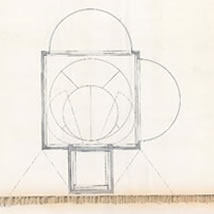 |
In the mid 70s I designed the Snowflake dome. It provides, in a lightweight, efficient and pleasing environment. the three basic kinds of spaces which are required by most living, working, learning activities. Additionally, the configuration of these spaces can “grow” organically as requirements dictate. The structure assembles and disassembles easily.
|
|
 |
In 1976 Draper Kaftan wrote Teaching the Future. In it he published Learning Objectives For a Future-Oriented Curriculum. Gail and i added to this in the early 80s and 90s to create The curriculum For the 21st Century. We added items throughout and two new sections: Bucky Fuller’s Design Science and the Arts. This entire curriculum was to be employed every year by every student in deeper iterations.
|
|
|
The Progressive Autonomy Model is a key concept of this method of education. Society today dovecotes the student too much and then virtually lest go of it in one year with predictably disastrous results. Meantime, the student is pursuing his/her own explorations covertly without benefit of guidance. The student is growing up in an abundance of mixed messages and passive behavior on on part of authority. |
|
|
In the late 70s, Gail and I explored the one-room school house and explore the economics of this configuration in a contemporary setting. We determined that a couple could teach 40 to 50 students, make a modest living, at the same cost per student as the Kansas City school district then spent. We had the opportunity to test this thesis for two semesters with public school students using the city as a classroom. |
|
|
In the early 80s, Gail and I developed the 5Es of Education Model to stress that these five factors had to be present in every learning experience - as a system - not separated or delivered sequentially. To this day, this Model is the criteria for every module - be it for learning or for design - in every event we design, teach or facilitate. Sadly, this is not yet an ubiquitous practice - EXPLORE being the most absent.
|
|
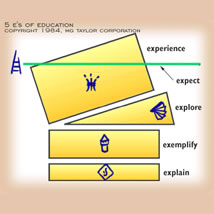 |
In 1983, MG Taylor was asked to provide a DesignShop to facilitate a rapid prototyping process for the Army to redesign its training program. Captain’s training for the Corps of Engineers was the prototype program. In preparation for this even I developed this Model which integrated, computer aided learning with expert’s mentoring in a peer review environment, with work all facilitated by a “navCenter.”
|
|
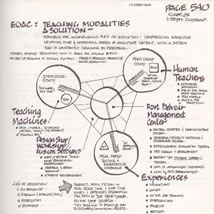 |
Our 1982 Vision of the integrated learning and workspace included large electronic work walls, wireless technology, full media remote collaboration, laptop computers, PDA's and the CyberCon System. We have been practicing this method for 25 years by a run-walk-run process employing knowledge workers to do the “walking” where technology did not exist, thus, establishing the protocols |
|
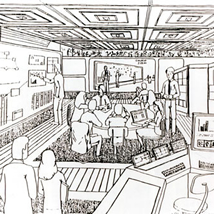 |
When we started this work in the 70s there did not exist an adequate language rigorously defining creativity, collaboration, learning, the function of networks - from neural to global commerce - as a system. It was necessary to create a word-graphical language that enabled us to “see” and creatively “engage” with this phenomena. We call this the MODELING LANGUAGE.
|
|
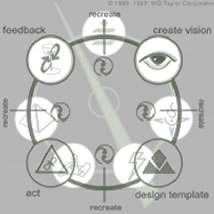 |
The Taylor System and Method is patented with elements in patent pending and preparation for such. Besides the IP issues, the value of this is that requires a rigorous thinking through and documentation of the method. The Method can be accessed from many different perspectives. In terms of the educational process, the 22 Habits of the Creative Person and the 22 Aspects of Memory are useful doors.
|
|
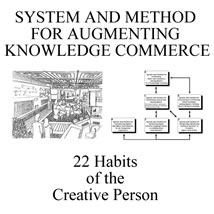 |
In 1992, Gail worked with the Knowledge Works Consortium to answerer a US government RFP the aim of which was to transform education. One consequence of this collaboration was The Path of leaning: The Five Points of Mastery Model. This Model outlines five practices that are essential for every learner to master and are also key for the proper functioning of a viable learning community.
|
|
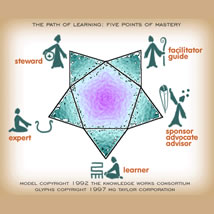 |
My argument that the economy is not the purpose of life - That obtaining “Right-Livelihood” is. This implication of this is that the purpose of education is not production of economic animals. Economy is, like ecology a integral part of the environment we live in and it should, like many subjects, be understood and integrated into a well rounded life. Nurturing the creative spirit and capacity is the true task of education.
|
|
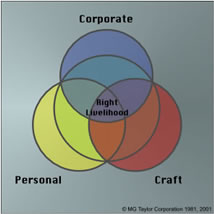 |
The masters Academy is the only educational facility that presently has a NavCenter on Campus. This facility has served staff, teachers and students in a variety of planning, design and learning experiences. While not a “classroom” traditional or future one, it has provided some insight into the interactions between the environment and student learning processes.
|
|
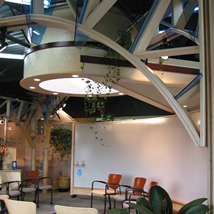 |
Learning is an emergent property. It is not predictable nor linear. The process of learning, however, can be facilitated so that results are consistent and reliable. Neither the learner nor the learning process - or the teacher for that matter - can be managed beyond the production of static, inadequate, dogmatic results. The environment of the Zone Of Emergence can be managed and that is point of this THESIS.
|
|
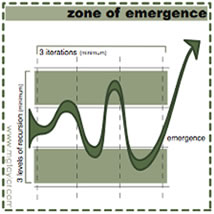 |
The UniCredit navCenter, completed January 2007, is our most mature, to date, expression of a multimedia augmented learning environment. This project is a model of what the large group “public” spaces in a 21st Century school can function. This space very nearly realizes all of the aspects of our 1982 vision minus the large work walls and the autonomous CyberCon technology. |
|
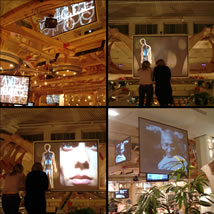 |
The mediaPOD is the modern version of the LearningPOD shown at the top of this stack. An application was first installed at the University of Virginia in April 2008. There are many configurations of this POD including becoming a personal student learning habitat. The concept of place has to be rendered on all levels of recursion from individual, to team, to group, entity and community.
|
|
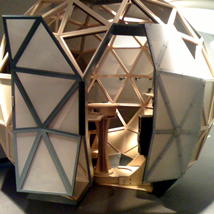 |
I believe personal teacher and student PODs are necessary for creating the kinds of social space necessary for true learning. There is a long history to support this viewpoint. Until now, however, it has been the province of the elite and not the common experience of all students. We need scholar activists, philosopher builders, spiritual business people, now - the question is how do you incubate them?
|
|
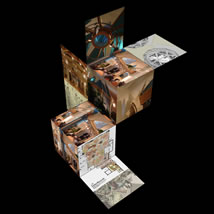 |
The Masters Academy Phase I expansion is a first step in applying the concept of the student-centered learning environment as outlined in this paper. An integral aspect of this new design is the integration of Masters’ Profound Learning System [link: pls]. The Masters Campus will ultimately incorporate all of the kinds of spaces discussed in THESIS, below.
|
|
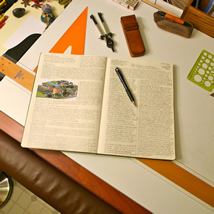 |
| This outline, above, sketches a 30 year development experienced-based effort to create a theory and method of education and creative living. It indicates how environment, process, knowledge augmentation tools and content must be merged to create a powerful learning experience. This method is the same - only with a different aim in mind - as the creative process which MG Taylor pioneered and has been employed thousands of times in large group collaborative design events all over the world during the last 28 years. |
| The focus of this paper is the student environment. Environment, in the broad sense - in the Taylor System and Method - is the totality of that which surrounds - in this case - the student. The physical place is of course part of this environment and so are the many recursion levels of place beyond this immediate skin: the building, campus, landscape, city, country, planet and so on. The social environment is a key aspect also; of most concern, here, are the rules-of-engagement by which the function of learning is conducted - for good or bad, this is a society of learning. The technology supports, extends and also makes up a part of this environment. The conduct of senior students and teachers, their frame of reference, and sense-of-life is perhaps the most critical environment making aspect. The content, also, is key - not only in the practical sense of preparing the student for a healthy and productive life but in the storehouse of options presented. To do both, this content must be present in the physical environment and it must be manifested in a past, present, future context. Education means “to lead out.” All this and more makes the environment for learning. This gestalt has to be supported by by an architecture which integrates shelter, arrangement of space and utilities and is an appropriate expression the aspirations of the learning community in a specific time and place and a network of places. |
| These considerations lead naturally to questions which have to be addressed in the process of designing a place for learning: |
| Does the school environment we have today meet present and future criteria? Is it “fit?” |
| What is the population of a modern school and what are their individual requirements? What size constitutes an effective learning community? |
| What kinds of spaces are necessary and what are the requirements for personal, team, group and large group spaces? |
| What is the range of learning modalities that have to be supplied? |
| What is the role of multimedia, computer aided learning and how is technology integrated seamlessly into the environment? |
| What makes the best settings for a school campus and what is the proper relationship between the community and the school? |
| What is the proper architectural expression of a school environment and its connected learning environments and what relative importance should society place on the making of these environments? |
|
|
| Addressing these questions is the THESIS of this paper. Answering them in the language of performance specifications [link: p.2 of 2] prepares us to begin to understand what an appropriate student environment of the 21st Century might be and what the gap is between this design ideal and the present situation. I will argue that the typical school environment in the modern “advanced” countries is more like a hospital or prison than a place to nurture the creative capability of a young life. Childhood is not a disease nor should students be incarcerated. The increasing institutionalization of our youth from school to military, to corporation, and for many - who do not make it - to jail, should be a concern for all. Even our much hyped “freedom” is not as free as is supposed. Just as a variety of goods is proliferating, the variety of acceptable thought and behavior is narrowing as is the variety of our natural landscape. Go into the typical institutional building in our human dominated world and ask yourself “where am I?” Identity and location - authentic place - is being lost. |
|
“Nobody can be saved from anything, unless they save themselves. It is hopeless doing things for people -- it is often very dangerous indeed to do things at all -- and the only thing worth doing for the race is to increase its stock of ideas. Then, if you make available a larger stock, the people are at liberty to help themselves from out of it. By this process the means of improvement is offered, to be accepted or rejected freely, and there is faint hope of progress in the course of the millennia. Such is the business of the philosopher, to open new ideas. It is not his business to impose them on people.”
“You did not tell me this before.”
“Why not?”
“You have egged me into doing things during all of my life... The Chivalry and the round table which you made me invent, what were these but efforts to save people, and to get things done?”
“They were ideas, ” said the philosopher firmly,“ rudimentary ideas. All thought, in its early stages, begins in action. The actions which you have been wading through have been ideas, clumsy ones of course, but they had to be established as a foundation before we could begin to think in earnest. You have been teaching men to think in action. Now it is time to think in our heads.”
“So my table was not a failure - master?”
“Certainly not. It was an experiment.”
T.H. White
1939
The Book Of Merlyn
pp 14 & 15
|
|
| There are some assertions that given modern technology and networks that the schoolhouse can go virtual and the school, aside from “baby-sitting” and socialization functions, is no longer necessary. I do not believe that this is true although not necessarily for the same reasons as those who argue for maintaining the status quo. To the extent that schools are there to baby sit and provide socialization, I do not believe this establishes any reason to keep them. Let us assume that all of the many technological projections will turn out to be valid and that this great capability will be added to our educational capacity. Let us assume virtual connectedness to many well appointed home centers of study - a subject I will get to. The reason to keep physical environments has to be justified only on the basis of what these environments can do that cannot be accomplished any other way. What this unique value is gets to the very heart of my educational and architectural philosophies. It should be realized, however, that this doing portends a massive change in both the environment and processes of the school as it is now practiced. A change that is at least a quarter of a century past due if not much longer. |
| Even in a virtual world, every node is someplace. The proper conclusion to draw from the network economy is not that the physical environment will diminish in importance. The proper conclusion is that each of us will have many widely distributed places to learn and work and that the ability to make and have PLACE in this circumstance is a primary skill to be developed. If anything, personal place become more important in the world we are building and must be exquisitely fit for each individual and not a mass produced box with some so-called individual frills and “options.” The typical school environment remains a monument to the paradigm of mass production and the subordination of the individual to the industrial process. The office is little better and adding “cyber-cafes” does little to change this intrinsically designed-in reality. All educators are futurists by definition: they deliver their mature product a generation later. A a minimum, the school should be the best simulation of the future circumstance the child will function in as an adult. This premise alone says that existing school architecture is a failure. |
| The school, of course, is a community and the larger community and world should not be divorced from it as has been the trend since WWII. There are several levels of recursion which have to be addressed from the individual student and teacher to the teacher-student interaction, to teams, group and full community scales of interaction - and, the interface of all this with the larger community outside of the school. Each of the recursion levels present a specific design challenge which has to be addressed. merely counting bodies and sizing the size of the box to hold them will not do. This assemblage, on all scales, exhibits network behavior. There is a great deal known about this yet little of it to date has been applied to the school learning environment which remains, essentially, mid 20th century process and architecture grown large with computers added. |
| On each level of recursion - from student to the greater community - there is a minimum critical mass required for each to work. This is a factor of the requisite variety issue. Proper scale of each kind of interaction is essential for optimum results. Again, there is a great deal of science known about this which has not found its way into school architecture which is still dominated by old real estate notions and UpSideDown economics. The only way that these real requirements can be met within reasonable economic realities is to great environments which can adjust in real-time to the ever changing pedagogical requirements. The rate of this changeability has to be accomplished on minute, hour, day, week, month and seasonal/annual increments. Reconfiguration has to be in the hands of the students and teachers not a detached “professional” cadre with their own agenda. |
| The schoolhouse is still primarily designed to accommodate a sit-and-get teacher-to-student one-way passing of information which is the most inefficient learning modality. New modalities are being added and that is the problem - they are being added. Instead, the process and environment, along with its technology augmentation, has to to be recreated with this new wealth of learning capabilities built-in from the beginning as an intrinsic aspect of the program and design. To do so will radically alter the design assumptions of the learning environment and the way that schools are designed, built, managed and used. |
| There are many different Models of cognitive types, preferred input and out put styles, kinds of intelligences personality type, and so on. Most likely, all of these are partially correct and not. They are, themselves, self referential - ourselves seeking to understand our self. The reality of brain and mind - and networks of minds - is far more complex than any of these Models. They have, however, utility in the aggregate. Create an environment(physical place, work-learning process and tool augmentation) that address all aspects of the se models and your are like to make an effective place for almost everyone. Transfer the method and make it possible for everyone to configure the details of their own experience and you will approach unity of success. |
| All media ia multimedia not just the technology of the moment. Each kind of media an inherent unique way of presenting the world. Each has limitations. Each has its own bias. Multimedia plays to each types strength and increases the chance of connecting with individuals different cognitive processes and leaning modalities. |
| The setting of a school is critical. Myself I prefer rural-wilderness or dense urban. I find the suburban setting less attractive. It has few of the advantages of the remote or the truly dense environs and most of the disadvantages of both. |
| I believe the attitude of a society which has a serious interest in preserving itself would be to put the greatest possible effort and resource into the task of educating its youth. I find the typical environment of the student does not reflect this concern. We do not pay teachers well nor are they generally highly regarded or influential in our society. A strange situation in a knowledge economy. The buildings are cold, hard and institutional. Technology is often behind the times when it should reflect the world they be living in not the past which is gone. One would think that the scholl would be the number one action research rapid prototyping environment. Not so. A rigid one method and content fits all instruction dominates the learning. It is designed to serve the convenience of the delivering system not the flowering of a unique mind and future life. What are we teaching our students by forcing then into this experience? |
| Our present school environment will not do. It must be re-conceived and re-built. Its place in our society has to return to the highest status we can give it. If we spend great time attention and expense anywhere it should be here. The school has to be an integral part of our total social life from the beginning of each life to the end of it. The school and the learning experience cannot remain isolated as it is today. We must address students where they are and open their minds to wider possibilities. Their self esteem can never be made to rest on the slippery foundation of pleasing us. It must rest on the rock of the student’s self tested and confirmed competency. Students have to become socially aware and able to function in their to time and place yet not “trained” to conform to any existing society, culture or philosophical norm no matter how valuable these may be. These values and realities are for them to choose and create. The role of education is to prepare, enable and inspire not propagandize and dictate. The student must be guided and disciplined, when necessary, yet the process must be consistent and just - with clearly stated and enforced rules - supporting a steady progressive step-by-step transfer of control to the student. Becoming an adult means the attainment of true self governance and responsibility. This cannot happen at some arbitrary age which is nothing more than a social compromise around a statistical average. Selfhood is learned and earned, progressively. For this to happen the student must must have absolute points of autonomy from the beginning with this arena of selfhood expanded by a mutually understandable and negotiated process with feedback and real consequences provided every step of the way. The student has to be protected from sever consequences yet failure must be allowed as this is where a great deal of learning happens. Student success - not conformity to the system - is what should be celebrated. The aim to to facilitate the emergence of a being greater than ourselves - if we fail at this, we fail at everything. |
|
|
The Education of a Heretic
I do not think I am a heretic yet the orthodoxy in several professions tends to think I am. A set of circumstances and subsequent experiences set me off in a direction from which there was no recovery. Be this good or bad in an open question yet to be answered. Click on the graphic to see how it all began...
|
|
| School of the Future - Today |
|
|
|
|
| A Future By Design Not Default |
|
|
|
|
| A Fu4 Step Recreation Process |
|
|
|
|
| A Practice - bringing idea into reality |
|
|
|
|
| The Solution Box Architecture |
|
|
|
Matt
Taylor
Elsewhere
January 1, 2008

SolutionBox
voice of this document:
VISION • PHILOSOPHY • PROGRAM
|
posted
January 1, 2008
revised
March 4, 2008
• 20080101.121231.mt • 20090124.391213.mt •
• 20080225.209911.mt • 20080301.879110.mt •
• 20080302.099156.mt •
200803004.000028.mt •
(note: this document is about 85% finished)
|
</script> |
|